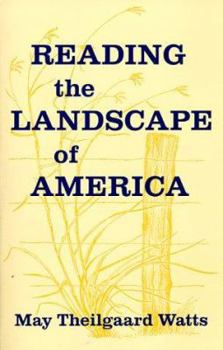Reading the Landscape of America
Select Format
Select Condition 
Book Overview
In this natural history classic, the author takes the reader on field trips to landscapes across America, both domesticated and wild. She shows how to read the stories written in the land,... This description may be from another edition of this product.
Format:Paperback
Language:English
ISBN:0912550236
ISBN13:9780912550237
Release Date:March 1999
Publisher:Nature Study Guild Publishers
Length:372 Pages
Weight:1.02 lbs.
Dimensions:0.8" x 5.5" x 8.5"
Customer Reviews
4 ratings
An incredible book
Published by Thriftbooks.com User , 16 years ago
I also have just finished reading a library copy of this book. It is unfortunate it is out of print, especially today when we are more aware of the environment and ecology. It is so beautifully written book, simple and spare and yet full of enthusiasm and sensitivity to how a botanist looks at the land. There are wonderful and innumerable sketches done by the author, showing how a pond or a bog or a forest changes over time. She has also imagined at the end of the book, a house and garden built in the 1600's and how design ideas in the following 300 years changed both the outside garden and the owners perspective on it. She even describes what kind of flowers they might have displayed in their living room and kitchen over the years. I urge all who may find this book to read it. You will look at the earth and care for all its inhabitants in a very new and peaceful way. I also urge someone to reprint it. The book's description of the vanishing ecology around us may renew our energies and commitment to save it.
lovely and accessible
Published by Thriftbooks.com User , 22 years ago
This is a book that people love and remember for many different reasons. I recently came across a 1998 article in the journal "Bioscene," called "Trees at the Center" by Maura Flannery, a professor of biology at St. John's University who writes widely about science education. Flannery says: "I read May Watts's Reading the Landscape of America years ago, and it remains one of my favorite books. There are several chapters on trees, but the one that has always stuck most firmly in my mind is the very first, on magnolias in the Great Smoky Mountains. In a lovely and accessible discussion of plant morphology and evolution, Watts explains why the magnolia is considered such an ancient species; why its flower form is considered primitive. She also discusses the remains of ice-age forests found on the upper slopes of the Smokies and the problem of trying to preserve these forests from human intruders."The chapter referred to is "In Search of Antiques, or The Forests of the Great Smoky Mountains." Its title evokes for me the image of the author standing by a Tennessee roadside at dusk, cupping a luminous white magnolia flower in her hands, and imagining the dawn of flowering life on earth. This is typical of May Theilgaard's writing--highly observant, imaginative, she sees deeply beyond the surface of things and teaches us to see more, also.
A Basic Primer for Nature Writers and Naturalist/ Ecologists
Published by Thriftbooks.com User , 24 years ago
I am thrilled that this book has been reprinted and recommend it to all who want to write about nature or who would become Ecologists or Naturalists. Watts writes with so much descriptive clarity that the scene and the natural occurances seem to come immediately to life on these pages. I have been to some of the areas she writes about and have a far more succinct appreciation for these landscapes. Should be recommended reading for every student of nature.
Take a field trip with one of America's favorite naturalists
Published by Thriftbooks.com User , 25 years ago
I have just finished reading a library copy of "Reading the Landscape". I enjoyed the book so much that I just had to have a copy of my own. May Watts was both a splendidly observant naturalist-scientist and a delightful writer as well. And boy...did I get a kick out of her little sketches...they're so great! If you are a lover of nature or nature writing, then this is a book for you. In a series of short essays Ms Watts describes her field trips across America, from the plains to the coasts, from the mountains to the deserts. In each location she comments on the interaction between the land and the types of plants found there. As Ms. Watts indicates it is often the plantlife that creates and molds the underlying landscape. In one of my favorite essays, she describes a train trip taken on January 1, 1954. Leaving Chicago at twilight, she notes the changing landscape seen through the train window on the way to Denver on that cold winter night. Her descriptions are accompanied by a series of little sketches showing the changing silhouettes of trees and homesteads as she leaves the city and outlying suburbs for the prairie farms of the heartland. In another essay, she attempts to date the age of an old abandoned country schoolhouse by observing the trees and other plants surrounding it. Sort of like a botanical Sherlock Holmes. May Watts' writing style always places the reader on the trail beside her whether examining the building of a sand dune or the ecology of a bog. She comes across like a scholarly botanist who also happens to be your favorite aunt. "Reading the Landscape" is the perfect book for those rainy weekends or cold winter nights when the naturalist is stuck inside. Dr. Bill Marszalec




